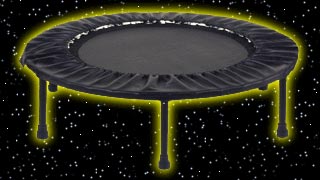Yield Strength - Rebounders
The yield is how far the springs stretch just by standing on the rebounder or bouncing. Some people prefer low while some people prefer a high yield.
Some springs have a higher yield as they lose their initial tensile strength and that makes them yield and high carbon springs can have a high yield without losing its strength so you don't have to keep changing springs every 2 years or every year if its going to be used by the whole family. Knowing about yield is important for heavier people buying a rebounder that have a low yield strength that cannot support their weight over time.
When you first buy nearly any rebounder, they can all have a high yield strength at first when you just bought it. The biggest complaint I get is after 2 years people need to buy a whole set of new springs or if a whole family is using a rebounder, after a few months the springs have stretched, and the heaviest person in the family is bottoming out the rebounder to the floor when jumping the same height they did when it was new.
Some of the rebounder companies have a lower price on their rebounder up front who use cheaper springs but know very sneakily they are going to get repeat business every few years when people need to reorder springs. This is how they make their money. After you buy. Not up front. The Needak and Rebound Air are the 2 higher end brands that I get more calls on than any others asking me if I sell their replacement springs. Also, the bungee rebounder cords have to be replaced more than any of the rebounders.
The springs with the lowest yield strength will usually start giving deeper bounces that get lower and lower in G force as they become less responsive. The more stretched out the rebounder springs are the more free bounces the rebounder spring will give. The springs are not giving a deep bounce because they have more coils. It means its the time to replace them. The new digitally tempered Cellerciser springs are the only springs I know of that never need to be changed. Their third tier of coils has so much yield and tensile strength that I would take someone over 350 pounds bouncing daily to stretch that third tier of coils out.
Getting a rebounder that has a high quality spring but has a low yield strength will give a super soft and deep bounce. The bungee cord rebounder has the lowest yield and gives the bouncer the most free bounces per jump. This is why it is very hard to do the health bounce on a bungee rebounder. The way that one of my customers figured out was by putting a stack of towels under the mat so that when you land you get at least a little ballistic impact to help flush the lymph valves. Also some of the rebounder companies are putting more porous mats, so it gives more free bounces. More air flow doesn't get blocked and so it won't be slowing the mat down. If someone wants to burn calories and have a great cardio workout, a laminated mat is the one that is preferred.
When a rebounder has too much yield in the spring, like on a bungee or a low carbon spring, once the free bounces have been used up and the momentum and inertia is no longer behind their weight. The mats that do not let much air through the mat are the ones I prefer if my goal is to do only the Health Bounce. If someone want to rely on using their own strength to gain free bounces, a rebounder with more initial tension will give me what I am looking for. When trying to rebound and a person does not have calve muscles that can support their bounce due to having the wrong yield and tensile strength, this is why people end up stopping rebounding. I strongly urge people to buy the rebounder that best fits their weight and bounce style.
Take my rebounding quiz if you need help picking out just the right rebounder.
I URGE PEOPLE TO TEST THE SPRINGS BEFORE YOU DO THE FIRST BOUNCE ON ANY REBOUNDER THAT USES ANALOG SPRINGS. USE A SCALE TO WEIGH EACH SPRING OR JUST TAKE A SPOON AND TAP ON EACH ONE IF YOU DON'T HAVE A SCALE. I WOULD NEVER KEEP SPRINGS THAT WEIGH DIFFERENTLY.
Take the
Take the
AVOID RIPOFF: DO NOT BUY ANY REBOUNDER BEFORE READING THIS
Beware of bogus rebounder reviews and fake comparison websites.
See the list of tricks rebounder companies use to trick you here.
1-877-354-3778
Open 7am till 11pm Eastern
Lymphaciser
LymphaticRebounding.com
Cellerciser
Bellicon
Needak
Rebound Air
URBAN
Lympholine
JUMP SPORT
Hexagonal
Bungee
Freedom Spring
1-877-354-3778
Open 7am till 11pm Eastern













